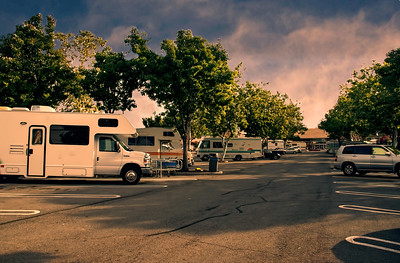Summary | Excerpt | Reviews | Beyond the Book | Read-Alikes | Genres & Themes | Author Bio

This article relates to If I Survive You
 In 2018, in Seattle's SoDo neighborhood, a woman named Sabrina Tate died inside her RV. She was almost 28 years old. A chronic drug user, Sabrina may have been killed by an infection. Two men living in the same vehicular lot, what was considered a safe space, had died there earlier in the year. Sabrina's parents, who had tried to help her overcome her heroin addiction, entered the RV after her death. They were hit with the sight of flies and rotted food in a disheveled living space — conditions of which they were previously unaware. "This is not a place anyone should want their daughter or son," Sabrina's father said. "Although it was called a safe lot or a safe zone, it was another place to put people so they are out of the way."
In 2018, in Seattle's SoDo neighborhood, a woman named Sabrina Tate died inside her RV. She was almost 28 years old. A chronic drug user, Sabrina may have been killed by an infection. Two men living in the same vehicular lot, what was considered a safe space, had died there earlier in the year. Sabrina's parents, who had tried to help her overcome her heroin addiction, entered the RV after her death. They were hit with the sight of flies and rotted food in a disheveled living space — conditions of which they were previously unaware. "This is not a place anyone should want their daughter or son," Sabrina's father said. "Although it was called a safe lot or a safe zone, it was another place to put people so they are out of the way."
Sabrina was part of the fastest-growing homeless subpopulation — those who sleep in cars or other vehicles. Jonathan Escoffery's collection of linked stories If I Survive You introduces vehicular homelessness into the plot by showing college graduate Trelawny living in his car, a bright red Dodge Raider. This is complicated. In the mall parking lot, Trelawny has to move his car every two hours to stay a step ahead of security guards who know he is using the mall as shelter. He lives in perpetual anxiety that he is going to run out of gas and the car will be towed.
The data tracking vehicular homelessness is spotty at best, particularly on the federal level, but Los Angeles County statistics show that, as of 2019, more than 40% of the homeless population there was living in vehicles such as cars, vans and RVs. HUD (the United States Department of Housing and Urban Development) defines those sleeping in "a place not designed for or ordinarily used as a regular sleeping accommodation" as "unsheltered homeless."
There are a multitude of reasons why people sleep in their vehicles. Job loss, other income struggles, domestic violence, and lack of support for mental and physical health issues, along with lack of family or friends who are able or willing to help, can all lead to people using their cars, vans, RVs or campers as a form of affordable housing. These vehicles grant a sense of safety and privacy that other forms of temporary housing for the homeless, like shelters, don't have.
"If we pay careful attention to the vehicles lining many city streets and even more remote areas we can see this crisis—people living in their vehicles as a last resort—is reaching an unprecedented pitch," said Sara Rankin, Director of the Homeless Rights Advocacy Project at Seattle University School of Law.
It's a particular problem on the West Coast where rents have skyrocketed, causing tenants to be displaced. Those living in their cars are vulnerable to theft and vandalism but may be reluctant to make a police report, fearing a ticket for parking in a restricted area or having their car impounded. They are often considered unwelcome by neighborhood residents or businesses who fear noise, trash, crime and the erosion of parking spaces, which in some areas are at a premium. The chances of retrieving a car, once impounded, can be slim for people living in financial despair.
In San Diego, the popular Safe Parking Program is run by a nonprofit called Dreams for Change. The rules are strict (no RVs, no one can enter the lot after 10 pm), but the program offers services such as food trucks serving affordable meals, financial assistance and job placement. Residents supervise each other. Case workers visit daily and around 40% of residents are able to transfer to housing within three to eight months.
"We were seeing a new wave of [homeless] people we hadn't seen before. It wasn't generational poverty. These were people who would come to us and say 'we aren't that kind of homeless,'" said Teresa Smith, executive director of Dreams for Change.
Lola Cheatham, a mother of three, was homeless for four years, sleeping in her minivan. Commenting on her preference to keep her family in their vehicle rather than living in a shelter in 2019, she said, "We are our own unit. We are in a controlled environment."
Naomi Lender, who was living in her car with her 14-year-old son at the Dreams for Change lot in 2018, told Slate, "People who are homeless in general, whether we're living in our cars or not, we're not all here because we want to be ... It's not because we're lesser humans. It can happen to anybody."
RVs in store parking lot. Photo by bluesbby (CC BY 2.0)
Filed under Society and Politics
![]() This "beyond the book article" relates to If I Survive You. It originally ran in September 2022 and has been updated for the
September 2023 paperback edition.
Go to magazine.
This "beyond the book article" relates to If I Survive You. It originally ran in September 2022 and has been updated for the
September 2023 paperback edition.
Go to magazine.
Your guide toexceptional books
BookBrowse seeks out and recommends the best in contemporary fiction and nonfiction—books that not only engage and entertain but also deepen our understanding of ourselves and the world around us.